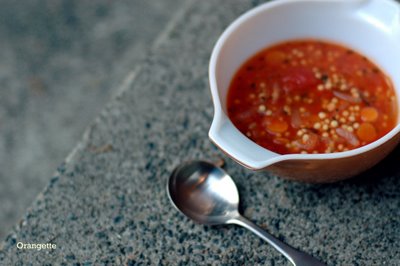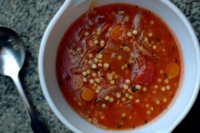On stewing, and soup
I haven’t been cooking much lately, and it’s got me feeling sort of sad. That Brandon, I tell you, has some kind of nerve. He’s been doing the cooking, nearly every night. I think I might be too lucky for my own good.
Now, hear me out. Before you rush to call me an ingrate, I should clarify: it is, of course, awfully nice to be betrothed to a man who not only can cook, but does. He makes a mouthwatering chana masala, any number of chutneys and spicy salsas, a golden fennel soup worthy of loud slurping, spicy soba noodles with lots of cilantro and radishes, sourdough pancakes, salads with delicious this and delicious that, and dressings to go with. Heck, he’s even started putting poached eggs on everything, and you know that makes me weak in the knees. Let’s not be silly: suffer, I do not. I love Brandon, and I love that Brandon cooks. But so much loving makes a girl very lazy, and rather lax when it comes to cooking.
For some people, this might not be a problem at all. For some, it might be close to paradise. And it is, sometimes — especially at the end of a long workday, and when I’m up to my ears, as I have been lately, in a side project that (dear sweet god permitting) will see the light of day sometime soon. But in the Before Brandon Era (B.B.E., as the historians might call it), when I was the sole cook in the kitchen, I had to step up to the stove and make something happen, no matter how long or how bad my day, and strange though it may seem, I liked it. For most of my adult life, the kitchen has been my place to think and brainstorm and sort things out, a place that forces me to slow down and settle into my senses. There is nothing to match the active meditation of moving a knife down the length of a carrot, or through a pile of coarse greens. Cooking is a way to make sense of my days, and to make something beautiful of them. We all find ways to do this, I think, whether we are conscious of it or not. For me, writing is another way, but it’s not the same. Cooking makes me generous. It makes me someone I want to spend time with. I didn’t know any of this, of course, until a certain curly-haired man came along and, ever so sweetly and with the best of intentions, started doing the cooking for me.
So I’ve been a little out of sorts, not knowing quite what to do with myself. But one night last week, I decided to make something of it — a soup, more precisely. I wanted something slow and quiet, sans sautéing and other jumpy methods, something that would make the kitchen warm and sweet-smelling, and me along with it. A riff on a recipe from September’s Gourmet sounded like just the thing: a fragrant soup made from the season’s last tomatoes, a pinch of summer-colored saffron, fresh herbs and fennel seeds, and, with a nod toward cold weather, a bit of orange zest.

I shooed Brandon away with a wooden spoon, and then, in the silent kitchen, sank my fingers into a bowlful of blanched tomatoes and coaxed from them all that early fall has to offer. Subtle, softly acidic, and laced with saffron, it was much tastier than stewing in my own juices. We scraped our bowls and looked at each other, and Brandon went back for a second helping.
Provençal Tomato Soup with Orange, Saffron, and Tiny Pasta
Adapted from Gourmet, September 2006
 This business of blanching, peeling, and seeding the tomatoes may be a little fussy, yes, but it makes for a lovely, soft tomato flavor. Plus, there’s nothing quite so satisfying for the fingers as slipping the skins from a few tomatoes, or scooping out their seeds and juicy slop. And aside from that mild labor, this soup is pretty straightforward. With a stir every now and then, it mainly cooks itself. And it makes for easy eating on the front stoop — a table for two with a view! — on an early fall evening. With a hunk of bread and some cheese alongside, it’s dinner.
This business of blanching, peeling, and seeding the tomatoes may be a little fussy, yes, but it makes for a lovely, soft tomato flavor. Plus, there’s nothing quite so satisfying for the fingers as slipping the skins from a few tomatoes, or scooping out their seeds and juicy slop. And aside from that mild labor, this soup is pretty straightforward. With a stir every now and then, it mainly cooks itself. And it makes for easy eating on the front stoop — a table for two with a view! — on an early fall evening. With a hunk of bread and some cheese alongside, it’s dinner.
2 lb good-tasting tomatoes
2 medium onions, peeled, quartered lengthwise, and thinly sliced (~2 cups)
1 medium carrot, finely chopped or cut into very thin rounds
1 celery stalk, finely chopped
4 large garlic cloves, minced
1 (3- by 1-inch) ribbon of fresh orange zest, minced
1 tsp finely chopped fresh thyme
Scant ¼ tsp dried hot red pepper flakes
¼ tsp fennel seeds
1 Turkish bay leaf
3 Tbs good-tasting olive oil
2 Tbs tomato paste
4 ¾ cups water
¾ tsp salt, or to taste
Pinch crumbled saffron threads
1 to 2 tsp granulated sugar
¼ cup small soup pasta, such as acini di pepe
2 Tbs finely chopped fresh Italian parsley
¼ cup finely chopped fresh basil
Bring a 5- to 6-quart saucepan of water to a boil. Cut a shallow X in the bottom of each tomato with a sharp knife, and blanch them, 2 or 3 at a time, in the boiling water for about 15 seconds, until the skin around the X starts to curl. Using a slotted spoon, transfer the tomatoes to a bowl of ice water. When they are cool enough to handle, peel them, core them, and halve them crosswise. Set a sieve over a medium bowl, and squeeze the tomato halves gently over it, cut sides down, to extract the seeds and pulp. You may have to use your fingers to coax them out. Press on the seeds in the sieve to push through any juice; then discard them. Reserve the juice and the tomatoes.
Pour the water out of the saucepan, and wipe it dry. Pour in the oil, and warm it over medium heat. Add the onions, carrot, celery, garlic, orange zest, thyme, red pepper flakes, fennel seeds, and bay leaf. Cook over medium heat, stirring occasionally, until the vegetables are very soft but not brown, about 8-10 minutes.
Add the tomatoes with their reserved juice and the tomato paste, water, salt, saffron, and 1 tsp sugar. Simmer, uncovered, stirring and breaking up the tomatoes with a spoon occasionally, about 25-30 minutes. Add the pasta, stir to mix, and simmer, uncovered, until tender, about 5 minutes. Discard the bay leaf, and stir in the parsley and basil. Taste, and adjust sugar and salt as needed. Serve.
Yield: 4-6 servings, depending on what else you’re eating

